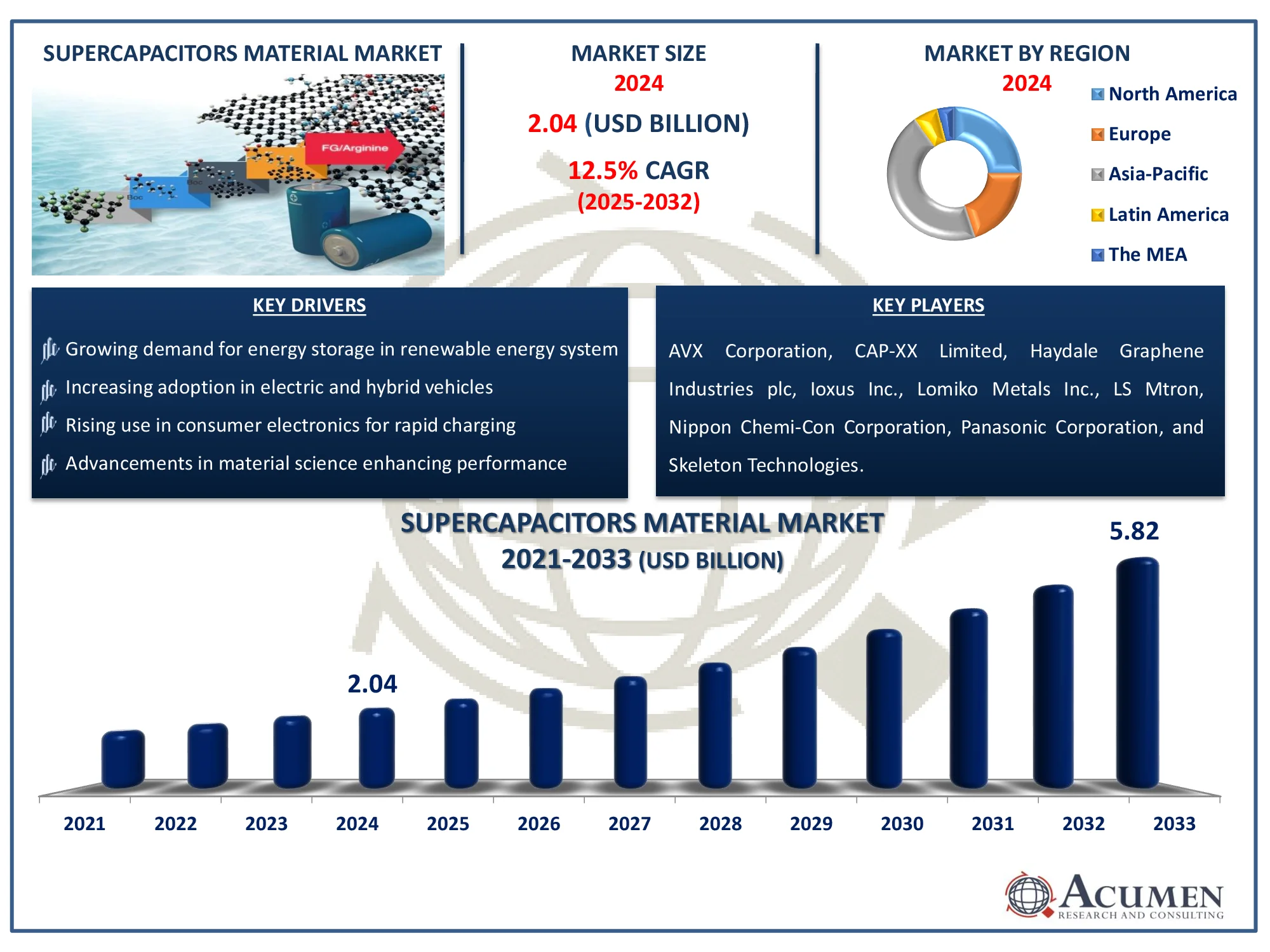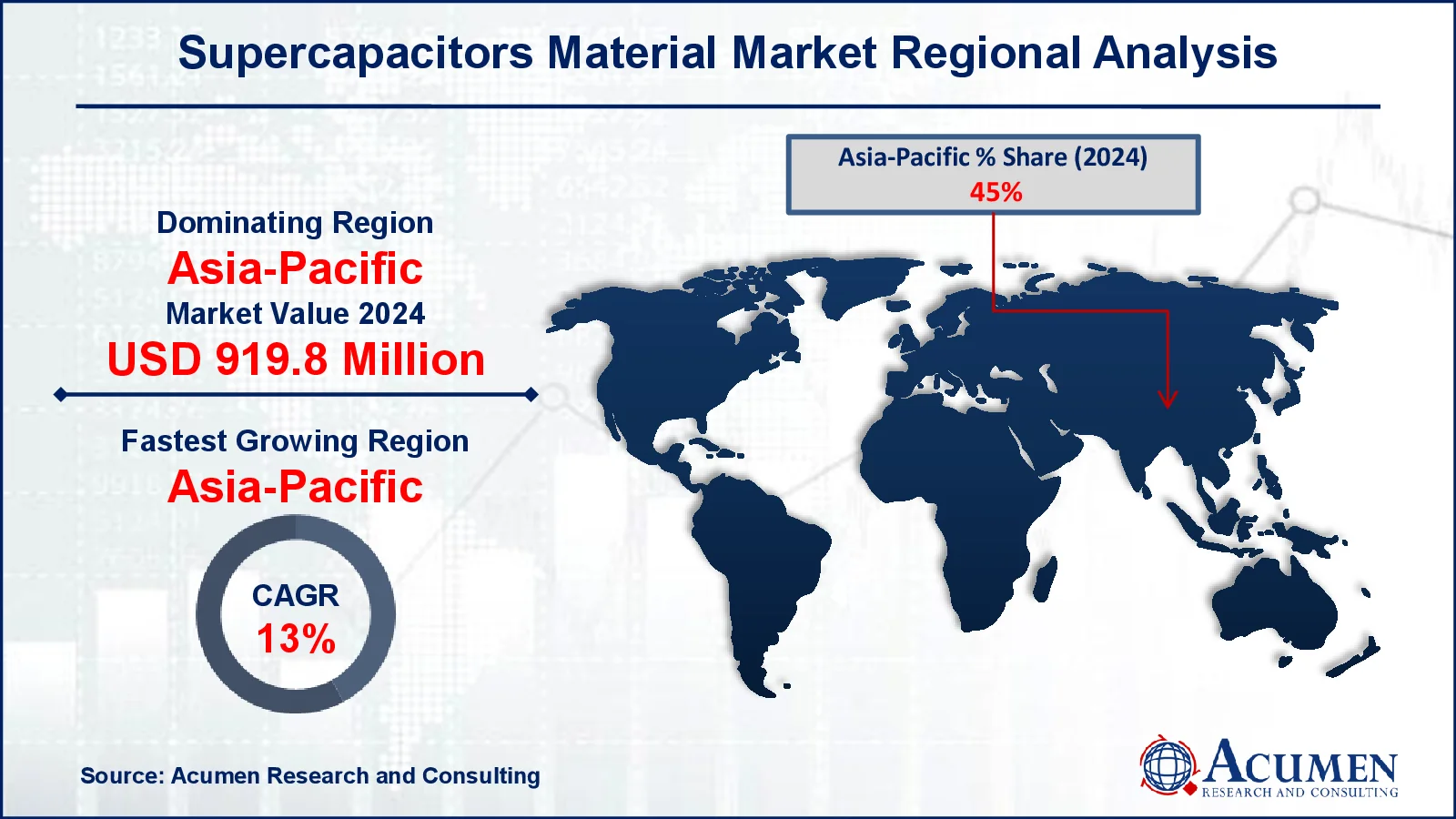September 2023
The Supercapacitors Material Market, projected to grow from USD 2.04 Billion in 2024 to USD 5.82 Billion by 2033, at a CAGR of 12.5%. Explore trends, growth factors, and forecasts.
The Global Supercapacitors Material Market Size accounted for USD 2.04 Billion in 2024 and is estimated to achieve a market size of USD 5.82 Billion by 2033 growing at a CAGR of 12.5% from 2025 to 2033.

Supercapacitor materials are specialized components used in the production of supercapacitors, which are energy storage devices known for their high power density, fast charge and discharge rates, and long cycle life. Supercapacitors are mostly composed of activated carbon, carbon aerogel, carbon nanotubes (CNTs), graphene, metal oxides, conducting polymers, and composite materials. These materials were chosen for their wide surface area for charge storage, high electrical conductivity, and stability across repeated charge-discharge cycles. Activated carbon is the most commonly used material due to its huge surface area and low cost, although advanced materials such as graphene and carbon nanotubes offer superior electrical and mechanical properties.
In addition to the primary electrode materials, supercapacitors have electrolytes, which can be aqueous or organic, as well as separators to prevent short circuits between electrodes. The materials employed in a supercapacitor have a significant impact on its performance metrics, including energy density, power density, and operating lifetime. Supercapacitor materials research and development are aimed at improving these performance parameters so that they can be employed in a wide range of applications, including consumer electronics, automotive, energy storage, industrial equipment, and aerospace and defense. Continuous advances in material science promise to increase the efficiency and affordability of supercapacitors, making them a viable alternative to traditional batteries in a wide range of applications.
|
Market |
Supercapacitors Material Market |
|
Supercapacitors Material Market Size 2024 |
USD 2.04 Billion |
|
Supercapacitors Material Market Forecast 2033 |
USD 5.82 Billion |
|
Supercapacitors Material Market CAGR During 2025 - 2033 |
12.5% |
|
Supercapacitors Material Market Analysis Period |
2021 - 2033 |
|
Supercapacitors Material Market Base Year |
2024 |
|
Supercapacitors Material Market Forecast Data |
2025 - 2033 |
|
Segments Covered |
By Material Type, By Capacitance, By Application, and By Geography |
|
Regional Scope |
North America, Europe, Asia Pacific, Latin America, and Middle East & Africa |
|
Key Companies Profiled |
AVX Corporation, CAP-XX Limited, Haydale Graphene Industries plc, Ioxus Inc., Lomiko Metals Inc., LS Mtron, Maxwell Technologies (a part of Tesla), Murata Manufacturing Co., Ltd., Nippon Chemi-Con Corporation, Panasonic Corporation, and Skeleton Technologies. |
|
Report Coverage |
Market Trends, Drivers, Restraints, Competitive Analysis, Player Profiling, Covid-19 Analysis, Regulation Analysis |
Several major factors affect the supercapacitor material industry. One important factor is the increasing demand for energy storage solutions in renewable energy systems. As the world shifts to more sustainable energy sources, the need for efficient and stable energy storage grows. Supercapacitors, with their high power density and fast charge/discharge rates, are ideal for balancing power supply and demand in renewable energy applications. Furthermore, the increasing popularity of electric and hybrid vehicles is driving market growth. These cars require efficient energy storage for applications such as regenerative braking and start-stop systems, and supercapacitors are an excellent choice because of their extended lifespan and rapid energy release.
Despite these positives, the market faces some obstacles that may limit its growth. One of the major challenges is the high initial cost of supercapacitors when compared to traditional batteries. This cost factor could be a significant barrier to wider adoption, especially in cost-sensitive applications and locales. Furthermore, the energy density of supercapacitors remains lower than that of traditional batteries, restricting its usage in applications that require long-term energy storage. Technical hurdles associated with large-scale manufacture of sophisticated materials such as graphene and carbon nanotubes pose further limits, as these processes can be complex and costly.
Nonetheless, the supercapacitors material market offers significant potential for expansion. The development of cost-effective and high-performance materials is a major focus of R&D, with the goal of overcoming current limitations and broadening supercapacitor applications. Emerging economies, particularly those in Asia-Pacific and Latin America, have substantial growth potential due to increasing infrastructure development and energy storage needs. Furthermore, rising investment in R&D for enhanced supercapacitor technologies is likely to drive innovation, resulting in more efficient and cost-effective solutions that can serve a wider range of applications. These factors are projected to drive market expansion in the supercapacitors material market forecast period.
 Supercapacitors Material Market Segmentation
Supercapacitors Material Market SegmentationThe worldwide market for supercapacitors material is split based on material type, capacitance, application, and geography.
According to the supercapacitors material industry analysis, activated carbon has dominated the supercapacitor material industry due to its broad availability, low cost, and large surface area, which is essential for energy storage. Activated carbon is commonly used in supercapacitors because it provides a large surface area for the electrochemical reactions required for energy storage, resulting in high capacitance and efficiency. Its low cost when compared to other complex materials like carbon nanotubes and graphene makes it a preferred choice among manufacturers. Activated carbon production procedures are also well-established and scalable, which contributes to the company's market leadership. While newer materials like graphene and carbon nanotubes outperform activated carbon, their high costs and production constraints have hindered their widespread application.
In 2024, the medium capacitance category (10 F - 100 F) accounted for the largest market share in the supercapacitor materials market. This segment strikes a compromise between power density and energy storage capacity, making it appropriate for a variety of applications such as consumer electronics, automotive, and industrial equipment. Medium capacitance supercapacitors are very popular in applications that require consistent performance, modest energy storage, and quick charge-discharge cycles, all of which are typical in these sectors. Their versatility and adaptability to many applications contribute to their market dominance, resulting in high demand and widespread adoption in 2024.
Supercapacitors are highly valued in automotive applications due to their high power density, fast charge and discharge times, and long cycle life, all of which contribute to improved vehicle performance and energy efficiency. As the automotive industry grows and advances, the need for supercapacitors is expected to rise, cementing its position as the market's dominant application. Supercapacitors are highly valued in automotive applications due to their high power density, rapid charge and discharge capabilities, and long cycle life, all of which contribute to increased vehicle performance and energy efficiency. As the automotive industry expands and evolves, demand for supercapacitors is likely to increase, reinforcing its position as the market's leading application.
North America
Europe
Asia-Pacific
Latin America
The Middle East & Africa
 Supercapacitors Material Market Regional Analysis
Supercapacitors Material Market Regional AnalysisThe supercapacitor material market is growing fast across geographies due to a multitude of factors. Rapid urbanization and development in Asia-Pacific are key drivers of the supercapacitors material market's expansion. China, Japan, and South Korea are at the forefront of production and technological research, contributing to the rising demand for supercapacitors in consumer electronics, automotive, and energy storage industries. The region's increased emphasis on renewable energy and electric vehicles promotes industrial development.
In North America, the industry is benefiting from technological improvements and increased investment in electric vehicles and renewable energy sources. The presence of large technical enterprises and research universities in the United States and Canada promotes market expansion. Similarly, Europe is growing due to strong regulatory support for green technologies, as well as advancements in the automobile and energy storage industries. European countries are investing heavily in electric vehicles and sustainable energy solutions, which is increasing demand for innovative supercapacitor materials.
Meanwhile, emerging markets in Latin America, the Middle East, and Africa have the potential to grow as infrastructure development and investments in energy storage solutions increase. However, these countries face disadvantages such as lower technological adoption and limited manufacturing capacity when compared to more developed regions.
Some of the top supercapacitors material companies offered in our report include AVX Corporation, CAP-XX Limited, Haydale Graphene Industries plc, Ioxus Inc., Lomiko Metals Inc., LS Mtron, Maxwell Technologies (a part of Tesla), Murata Manufacturing Co., Ltd., Nippon Chemi-Con Corporation, Panasonic Corporation, and Skeleton Technologies.
Looking for discounts, bulk pricing, or custom solutions? Contact us today at sales@acumenresearchandconsulting.com
September 2023
January 2024
December 2022
April 2020